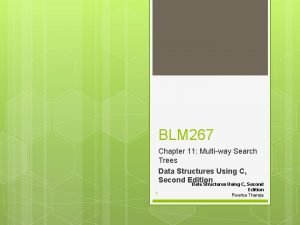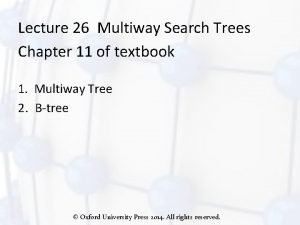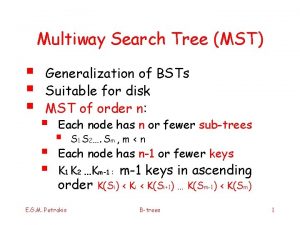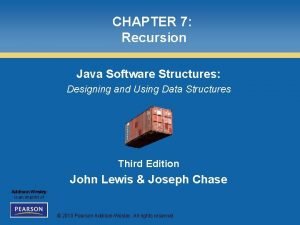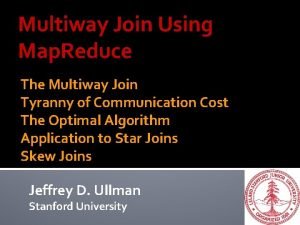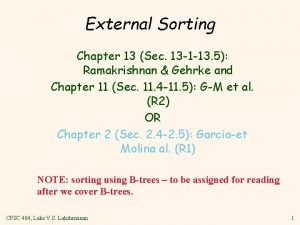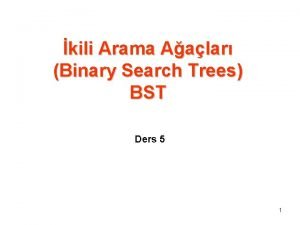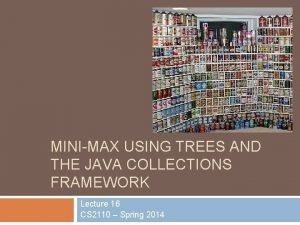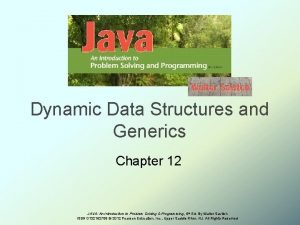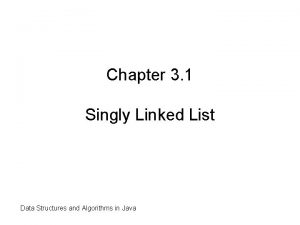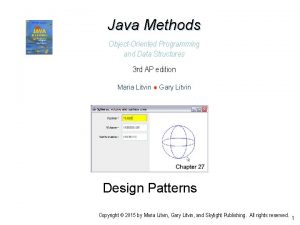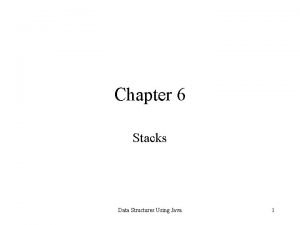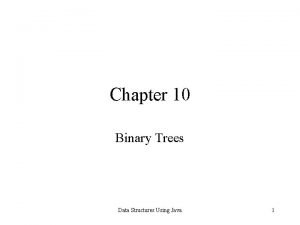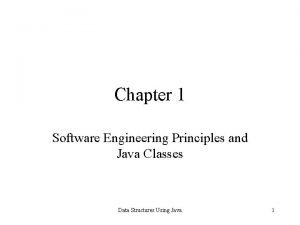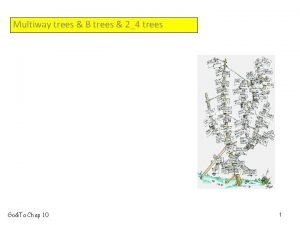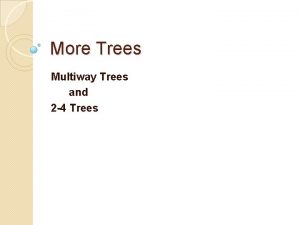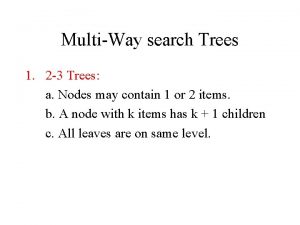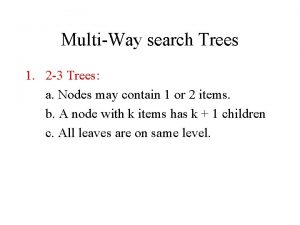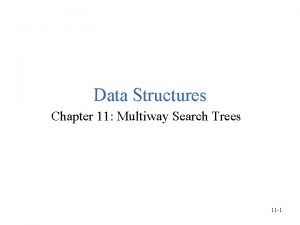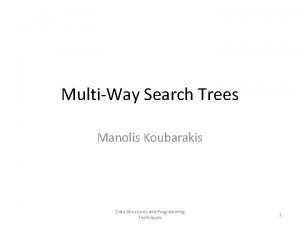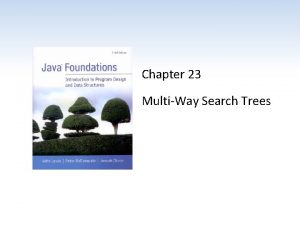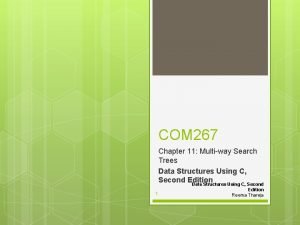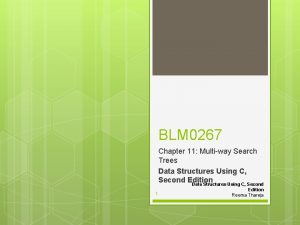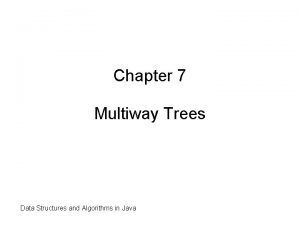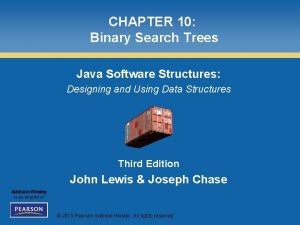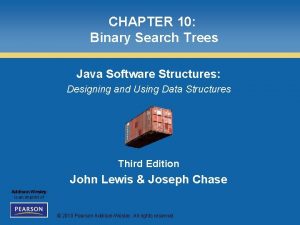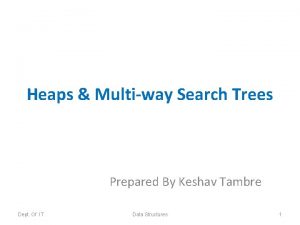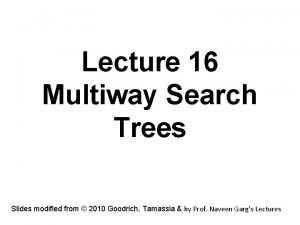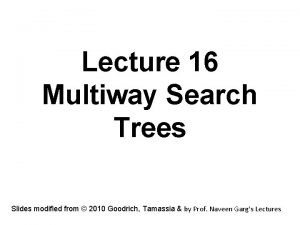CHAPTER 12 Multiway Search Trees Java Software Structures


























- Slides: 26

CHAPTER 12: Multi-way Search Trees Java Software Structures: Designing and Using Data Structures Third Edition John Lewis & Joseph Chase Addison Wesley is an imprint of Modified by Chuck Cusack, Hope College © 2010 Pearson Addison-Wesley. All rights reserved.

Chapter Objectives • Examine 2 -3 and 2 -4 trees • Introduce the generic concept of a B-tree • Examine some specialized implementations of B-trees 1 -2 © 2010 Pearson Addison-Wesley. All rights reserved. 1 -2

Multi-way Search Trees • In a multi-way search tree, – each node may have more than two child nodes – there is a specific ordering relationship among the nodes • In this chapter, we examine three forms of multiway search trees – 2 -3 trees – 2 -4 trees – B-trees 1 -3 © 2010 Pearson Addison-Wesley. All rights reserved. 1 -3

2 -3 Trees • A 2 -3 tree is a multi-way search tree in which each node has zero, two, or three children • A node with zero or two children is called a 2 -node • A node with zero or three children is called a 3 -node 1 -4 © 2010 Pearson Addison-Wesley. All rights reserved. 1 -4

2 -3 Trees: 2 -Nodes • A 2 -node contains one element and either has no children or two children – Elements of the left sub-tree less than the element – Elements of the right sub-tree greater than or equal to the element 1 -5 © 2010 Pearson Addison-Wesley. All rights reserved. 1 -5

2 -3 Trees: 3 -Nodes • A 3 -node contains two elements, one designated as the smaller and one as the larger • A 3 -node has either no children or three children • If a 3 -node has children then – Elements of the left sub-tree are less than the smaller element – The smaller element is less than or equal to the elements of the middle sub-tree – Elements of the middle sub-tree are less then the larger element – The larger element is less than or equal to the elements of the right sub-tree 1 -6 © 2010 Pearson Addison-Wesley. All rights reserved. 1 -6

2 -3 Trees • All of the leaves of a 2 -3 tree are on the same level • Thus a 2 -3 tree maintains balance 1 -7 © 2010 Pearson Addison-Wesley. All rights reserved. 1 -7

Inserting Elements into a 2 -3 Tree • All insertions into a 2 -3 tree occur at the leaves – The tree is searched to find the proper leaf for the new element • Insertion has three cases – Tree is empty • Create a new 2 -node, insert the element into the 2 -node, and make it the root. – Insertion point is a 2 -node (next slide) – Insertion point is a 3 -node (a few slides later) 1 -8 © 2010 Pearson Addison-Wesley. All rights reserved. 1 -8

Inserting in a 2 -node • Add the element to the leaf and make it a 3 -node • E. g. insert 27: 1 -9 © 2010 Pearson Addison-Wesley. All rights reserved. 1 -9

Inserting in a 3 -node • The 3 elements (the two old ones and the new one) are ordered • The 3 -node is split into two 2 -nodes, one for the smaller element and one for the larger element • The middle element is promoted (or propagated) up a level. There are 2 cases: – The parent of the 3 -node is a 2 -node – The parent of the 3 -node is a 3 -node 1 -10 © 2010 Pearson Addison-Wesley. All rights reserved. 1 -10

Insertion into 3 -node (continued) • If the parent of the 3 -node being split is a 2 -node then it becomes a 3 -node by adding the promoted element and references to the two resulting two nodes • E. g. Inserting 32: 1 -11 © 2010 Pearson Addison-Wesley. All rights reserved. 1 -11

Insertion into 3 -node (continued) • If the parent of the 3 -node is itself a 3 -node then it also splits into two 2 -nodes and promotes the middle element again • E. g. inserting 25: 1 -12 © 2010 Pearson Addison-Wesley. All rights reserved. 1 -12

Removing Elements from a 2 -3 Tree • Removal of elements is also made up of three cases, based on the location of the element to be removed: – a leaf that is a 3 -node – a leaf that is a 2 -node – an internal node 1 -13 © 2010 Pearson Addison-Wesley. All rights reserved. 1 -13

Case 1: 3 -node leaf • The simplest case is that the element to be removed is in a leaf that is a 3 -node • In this case the element is simply removed and the node is converted to a 2 -node 1 -14 © 2010 Pearson Addison-Wesley. All rights reserved. 1 -14

Case 2: 2 -node leaf • This creates a situation called underflow • We must rotate the tree and/or reduce the tree’s height in order to maintain the properties of the 2 -3 tree • This case can be broken down into four subordinate cases 1 -15 © 2010 Pearson Addison-Wesley. All rights reserved. 1 -15

Case 2. 1: 2 -node leaf case 1 • The 2 -node has a right child that is a 3 -node – In this case, we rotate the smaller element of the 3 -node around the parent 1 -16 © 2010 Pearson Addison-Wesley. All rights reserved. 1 -16

Case 2. 2: 2 -node leaf case 2 • The underflow cannot be fixed through a local rotation but there are 3 -node leaves in the tree – In this case, we rotate prior to removal of the element until the right child of the parent is a 3 -node – Then we follow the steps for our previous case 1 -17 © 2010 Pearson Addison-Wesley. All rights reserved. 1 -17

Case 2. 3: 2 -node leaf case 3 • None of the leaves are 3 -nodes but there are 3 -node internal nodes – In this case, we can convert an internal 3 -node to a 2 -node and rotate the appropriate element from that node to rebalance the tree 1 -18 © 2010 Pearson Addison-Wesley. All rights reserved. 1 -18

Case 2. 4: 2 -node leaf case 4 • There not any 3 -nodes in the tree – This case forces us to reduce the height of the tree – To accomplish this, we combine each the leaves with their parent and siblings in order – If any of these combinations produce more than two elements, we split into two 2 -nodes and promote the middle element 1 -19 © 2010 Pearson Addison-Wesley. All rights reserved. 1 -19

Case 4: internal node • As we did with binary search trees, we can simply replace the element to be removed with its inorder successor 1 -20 © 2010 Pearson Addison-Wesley. All rights reserved. 1 -20

2 -4 Trees • 2 -4 Trees are very similar to 2 -3 Trees adding the characteristic that a node can contain three elements • A 4 -node contains three elements and has either no children or 4 children • The same ordering property applies as 2 -3 trees • The same cases apply to both insertion and removal of elements as illustrated on the following slides 1 -21 © 2010 Pearson Addison-Wesley. All rights reserved. 1 -21

B-Trees • Both 2 -3 trees and 2 -4 trees are examples of a larger class of multi-way search trees called B-trees • We refer to the maximum number of children of each node as the order of a B-Tree • Thus 2 -3 trees are 3 B-trees and 2 -4 trees are 4 B-trees • B-trees of order m have the following properties: 1 -22 © 2010 Pearson Addison-Wesley. All rights reserved. 1 -22

A B-tree of order 6 1 -23 © 2010 Pearson Addison-Wesley. All rights reserved. 1 -23

Motivation for B-trees • To make the most efficient use of the relationship between main memory and secondary storage • Until now, we have assumed that an entire collection (data structure) exists in memory at once • What if the collection is too large to fit in memory? • B-trees were designed to flatten the tree structure and to allow for larger blocks of data that could then be tuned so that the size of a node is the same size as a block on secondary storage • This reduces the number of nodes and/or blocks that must be accessed, thus improving performance 1 -24 © 2010 Pearson Addison-Wesley. All rights reserved. 1 -24

B*-trees • A variation of B-trees called B*-trees were created to solve the problem that the B-tree could be half empty at any given time • B*-trees have all of the properties as B-trees except: – in a B*-tree, each node has k children where (2 m– 1)/3 ≤ k ≤ m • (Recall that for a B-tree it was: m/2 ≤ k ≤ m) • This means that each non-root node is at least two-thirds full 1 -25 © 2010 Pearson Addison-Wesley. All rights reserved. 1 -25

B+-trees • Another potential problem for B-trees is sequential access • B+-trees provide a solution to this problem by requiring that each element appear in a leaf regardless of whether it appears in an internal node • By requiring this and then linking the leaves together, B+trees provide very efficient sequential access while maintaining many of the benefits of a tree structure 1 -26 © 2010 Pearson Addison-Wesley. All rights reserved. 1 -26
 Multiway search tree
Multiway search tree Multiway search tree
Multiway search tree 105 ×106
105 ×106 Java software structures 4th edition
Java software structures 4th edition Two way selection and multiway selection
Two way selection and multiway selection Multiway selection
Multiway selection Multiway selection flowchart
Multiway selection flowchart Multiway trie
Multiway trie Multiway join
Multiway join Two phase multiway merge sort
Two phase multiway merge sort Pentaho multiway merge join
Pentaho multiway merge join How are the whale flipper and the human arm different
How are the whale flipper and the human arm different Ternary search trees
Ternary search trees Binary search trees
Binary search trees Java collections tree
Java collections tree Advanced data structures in java
Advanced data structures in java Java dynamic data structures
Java dynamic data structures Data structures and abstractions with java
Data structures and abstractions with java Java data structures
Java data structures Data structures in java
Data structures in java Data structures in java
Data structures in java Data structures using java
Data structures using java Binary search tree java
Binary search tree java Data structures using java
Data structures using java Uninformed search algorithm
Uninformed search algorithm Federated search vs discovery
Federated search vs discovery Local search vs global search
Local search vs global search
